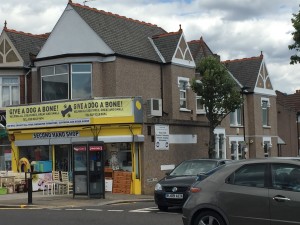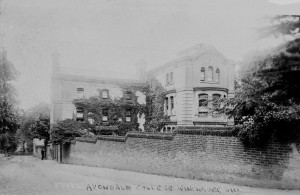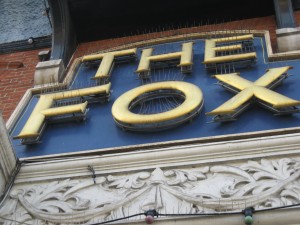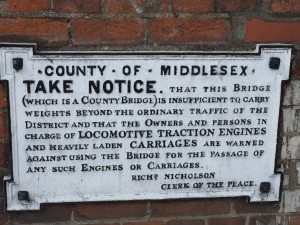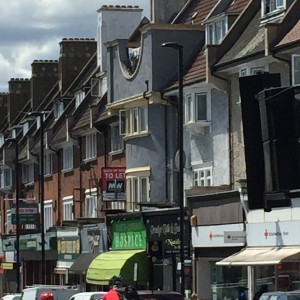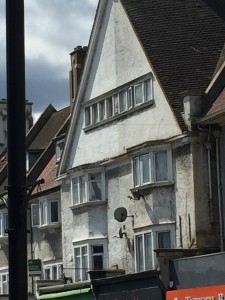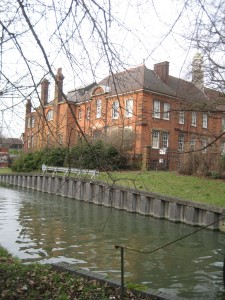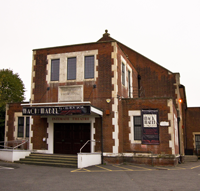
A giant mast towered above the Intimate Theatre, dwarfing neighbouring St Monica’s Church. Below, the car park buzzed with BBC crew, clutching clipboards and hurrying about with technical equipment. Inside the theatre, dressed up to the nines, the audience hummed with excitement, chirruping to neighbours while they waited for the performance to start and the cameras to roll. It was 2 December 1946 and the Intimate Theatre Palmers Green was about to play host to a first – the broadcast of a play live on television – George and Margaret, a comedy by Gerald Savory.
It had always been the intention that the Intimate would accommodate some theatrical productions, but national fame certainly hadn’t been part of the original plan. The theatre had begun its life as St Monica’s Church Hall in 1931. Opened by Cardinal Bourne, it had been built by the church as a place for good clean fun – church groups and meetings, dancing – there was a sprung floor – and yes, a little amateur dramatics – there was modern equipment and a balcony. In the 1930s, people made their own fun.
It all changed when in 1935 25-year-old John Clements approached the church with plans to run his own theatre. Clements was already beginning to make a name for himself on stage and screen but the circumstances under which he came to be able to put in a bid for the Intimate and the exact financial arrangements with St Monica’s don’t seem entirely clear – or indeed why he chose Palmers Green, though the hall appears to have been just the right size for his plans. Perhaps it was PG’s reputation for manicured respectability and keeping-up-with-the-neighbours, including in matters of culture. Most nearby theatres focused on variety performances – there was nothing in the area catering to a higher brow.
Whatever went on behind the scenes in securing a lease from St Monica’s only four years after they had built the hall for themselves, Clements got his wish. Among the plans were new seating, but, says Geoff Bowden in his fascinating book about the Intimate, all did not go quite to plan. The first play to run at the Intimate was to be Dover Road by AA Milne on Boxing Day 1935. The delivery of the new seats on Christmas Eve was delayed and workmen downed tools. Undaunted the actors rolled up their sleeves and did it themselves, and then did the show!
After a short interlude the theatre opened proper and from January 1936 began the reperatory theatre traditional routine of a play a week which was to continue for many years.
The process of a play a week at the Intimate was certainly more arduous than glamorous. At any one time the company would be performing one play, rehearsing another, and learning lines for a third. The conditions were not luxurious. The stage at the Intimate was small and going from one side to the other out of sight of the audience required actors to leave the building through one door, walk around the back, and enter through another (eventually a covered walkway was installed to protect the actors from the elements.)
Early days were precarious, and though productions often got rousing responses, the quality could, apparently be quite variable. Stevie Smith was a regular among the audience and wrote to friends in 1937 that she was glad she hadn’t waited for a production of a new play to arrive on her home turf at the Intimate ‘and almost certainly risk its mangling by an indifferent cast’.
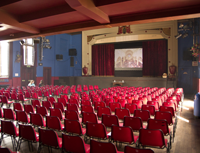
The Intimate Theatre was also ‘intimate’ in all senses. Though its reputation meant that it attracted audiences from far and wide, the core audience was drawn from Palmers Green and its close environs – a trip to the Intimate meant a chance to catch up with your neighbours over a cup of coffee served to you at your seat. The resident company also meant the cast was tight-knit and the audience developed particular favourites. Some among the regular cast, like Sheila Raynor and husband Keith Pyott, lived locally – in their case just a stumble away in Stonard Road. Another Intimate regular who lived locally was Brian Hayes, Patricia Hayes’ brother.
From the 1930s onwards, the Intimate attracted a host of famous and soon to be famous actors. June Whitfield appeared at the Intimate in 1946 and 1947, and was mortified to be out for a coffee with a friend when she realised that she should be in the afternoon matinée, the timing of which had recently changed. She arrived for the second act, which must have been somewhat confusing for the audience. Richard Attenborough made his debut performance in Eugene O’Neill’s Ah Wilderness. Irene Handl appeared in the forties and then again in 1965, and EastEnders’ Anna Wing in several plays in the 1940s. Nicholas Parsons was also a regular for a while. Later, there were performances by a freshly demobbed Roger Moore, Arthur Lowe, Bill Owen, John Inman, Dad’s Army writer Jimmy Perry and his wife Gilda, Tony Blackburn and, strangely, Stephen Berkoff.
Unfortunately television, the medium which had helped put the Intimate on the map, eventually became its biggest challenge – people were choosing to stay indoors and be entertained in the comfort of their own homes. By the 1960s the Intimate was the only reperatory theatre left in London and a bingo and social club was created to try to boost income, amidst protests from the regulars. By 1967 the theatre was receiving support from Enfield council and Director Earnest Dudley was trying to boost audiences by introducing new casts for each production. Unfortunately this had the effect of alienating some of the local audience and an attempt to backtrack and go back to a company didn’t seem to help
It was around this time that the Intimate hosted perhaps the most unusual performance in its eventful history. In November 1968, a 21-year-old David Bowie appeared in a mime improv production called Pierrot in Turquoise. Bowie was far from famous at the time. He had only released one album as a solo artist and was still 8 months away from the breakthrough single Space Oddity. Devised by dancer and choreographer Lindsay Kemp, who was to radically influence Bowie’s approach to performance, the five songs featured in the production were all written by Bowie. The four nights at Palmers Green appear to have been the last time the production was performed live. The website IMDb.com gives the plot synopsis of the TV version thus:
“Pierrot is a freaky mime who ventures into a mirror where he falls in love and rolls around with the equally grotesque Columbine. But when Columbine beds black stallion (in half-assless spandex) Harlequin, Pierrot’s jealousy takes over and drives him to murder. Cloud (Bowie) watches over the proceedings from his perch (on a ladder!) and narrates in song.”
Unmissable. Though most of us did.
The Intimate closed as a rep theatre in 1969 and reverted to a parish hall. All was not lost however and the theatre continued as a venue for local amateur groups, as it does to this day.
One off events also continued. The 60s and 70s saw performances from The Wurzels, Joe Brown, George Melly, Tommy Trinder, and Hinge and Bracket. There was also a tradition of panto, attracting stars such as Bill Pertwee, Ruth Madoc, and Tony Blackburn. Bill Owen wrote and performed in Mother Goose, and John Noakes starred in Cinderella in 1986.
Though performances are now by local societies, the Intimate remains at the heart of PG’s history and community. If you would like to find out more about the story of the Intimate Theatre, please do seek out Geoff Bowden’s fascinating book, The Intimate Theatre.
Nomination for the local list of heritage assets: The Intimate Theatre, Green Lanes
- This article has been prepared as part of the process to nominate buildings and landmarks to Enfield’s updated local list. For more information see http://www.palmersgreenn13.com/2015/09/11/every-street-in-palmers-green/. And if you have any suggestions for buildings which aren’t listed but should be included in the local list, please get in touch. But do get in touch soon, as submissions need to be in by the second weeks in November.
